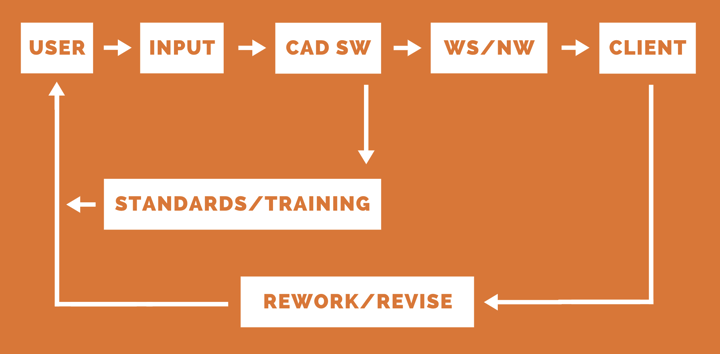I frequently talk about the CAD ecosystems that we manage, rather than just the CAD we manage. Why is that? Well, because CAD management is about a lot more than just CAD! Many things must be done correctly to get quality CAD/building information modeling (BIM) work done, and that entire ecosystem of components and workflow must be properly harmonized to work smoothly.
So the question I’m often asked is, “OK then, what part of the CAD ecosystem should I focus on?” Often, I’m met with a surprised look when I respond, “Whatever part is working the worst — the bottleneck.” In this edition of the CAD Manager’s Newsletter, I’ll begin a two-part series explaining how to analyze and “un-bottleneck” your CAD ecosystems for maximum efficiency. Here goes.
The Ecosystem Defined
A CAD ecosystem can be thought of like a collection of components all working in series. And given a series-style architecture, it stands to reason that the entire ecosystem is limited by how well its slowest component performs. That slowest component is therefore known as the bottleneck (more on that a bit later).
I like to think of the CAD ecosystem in a chronological sequence that describes how CAD work gets done — like this:
-
The user. The first link in the series. Users convert thoughts into CAD instructions, so the more standardized the user’s performance is, the better the entire ecosystem will work.
-
Input devices. Mice, trackballs, point-cloud scanners, digital cameras — they all assist the user in capturing information and conveying it to CAD software.
-
The CAD software (CAD SW). The software that stores the user input and processes it all into a final work product. Whether it is a desktop application or browser-based app is immaterial, because either way, the user sees it as their design software tool.
-
The workstation/network (WS/NW). None of the user input means anything without a fast workstation and network to process, transfer, and store the CAD data.
-
The standards/training regimen. The better the users are trained and the better our standard procedures are, the better the software will serve us.
-
Output devices. 2D/3D printers, plotters, PDF capture software, etc. — they all capture the work product for delivery to clients, shop floor, or the field. If the output isn’t correct, none of the other components matter much!
-
The revise/rework process. As design reviews, checking, and evolving design parameters necessitate changes, the entire process reverts back to the user and everything starts again.
Of course, you may need to add in some additional components to describe your CAD ecosystem, but the checklist above should give you a good starting point.
Bottlenecks and Process Flow
Now that you’ve listed your CAD ecosystem components, you can start to visualize how CAD tasks actually flow through your office like a logic diagram.
The mental picture that emerges for me looks something like this:
When you diagram your CAD ecosystem in this manner, a few conclusions will pop out almost immediately:
-
Your ecosystem is mainly sequential, with a few feedback loops
-
Standards drive how information is input, thus lessening the chance for errors
-
The more you iterate/revise/rework, the longer the entire process takes
-
The entire ecosystem is only as good as its weakest link (the bottleneck).
I’ve found it fascinating over the years to map this type of diagram out for clients and ask them where their weakest links/bottlenecks are, only to be met with blank stares and no real ideas on where the true problems lie.
Irrefutable Bottleneck Truths
Stepping through the components of the CAD ecosystem, I’ll offer some “irrefutable truths” I’ve come to believe after years of experience. I’ll relate each of these to their bottleneck potential for many companies.
The user/standards. If your users don’t know what they are doing, nothing else matters. The bottleneck potential here is huge if a user is “thrown into” a new CAD program they are not trained for. Other bottlenecks may also creep in at the user level, such as not following standards or not being trained in the use of those standards. As the first component of the CAD ecosystem, well-trained and thoroughly standardized users are the key to un-bottlenecking the total ecosystem.
Input devices. Great input devices enable users to get information into their CAD tools and visualize complex 3D systems with the least amount of wasted time. The bottleneck potential here is larger than you might think — and the cost may be less than you think. It turns out that a $99 Space Controller and a high-performance GPU in the user’s workstation can really speed up 3D visualization in mechanical CAD and BIM modeling. Think about what saving 15 minutes a day for a user adds up to over the course of the year, and you’ll realize how simple investments in input devices can easily un-bottleneck this part of the ecosystem.
The CAD software. Is the software properly configured? Are all pertinent components/families/blocks loaded? Are menus/palettes functional and logical? These are the things that make CAD software either easy or hard to work with. So, it stands to reason that CAD managers who set their CAD software up properly will automatically prevent — or fix —bottlenecks this part of the ecosystem.
The workstation/network. Workstations/networks that run software briskly with no noticeable delays, glitches, or crashes keep your users happy and productive. The bottleneck potential associated with old, unreliable, and frequently crashing hardware/networks can’t be overstated. The other thing to note is that workstations/networks don’t argue about standards and they never skip training — so if you just spend the money on the right hardware, un-bottlenecking happens on its own.
The standards/training regimen. This component can’t be separated from item #1 — the user. After all, users who are well trained and work in a well-standardized environment will always be more efficient than those who aren’t/don’t. The bottleneck potential here is huge, and it can undermine everything that you’re doing right.
Output devices. This is how your clients judge you — by your final product. The bottleneck potential here is typically from using slow or low-volume output devices in high-throughput environments. And if you’ve abandoned hard-copy plotting in favor of PDF capture, having the right drivers and publishing setups is crucial. CAD managers who understand that the end game is all about the output will spend the time to organize and un-bottleneck the output tools in their ecosystems.
The iterative/revision process. The more times you must iterate and revise, the more time your users spend on the project, and the more any bottlenecks you do have are magnified. Therefore, anything you can do to eliminate errors and un-bottleneck the overall ecosystem will reduce the chance of rework.
Summing Up
In the second part of this series, we’ll discuss how to find your biggest bottlenecks, quantify them, and start a prioritized process of eliminating them. To prepare, I suggest you take some time now to create your own ecosystem diagram and think about where the bottlenecks in your system might be. Until next time.
Robert Green
Robert Green performs CAD programming, standardization, and consulting services globally. He is the author of Expert CAD Management: The Complete Guide. Reach him via his website (greenconsulting.com/).
View All Articles





Share This Post